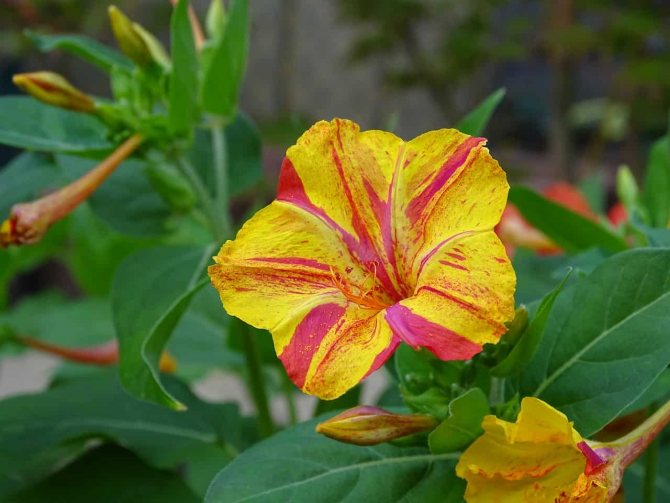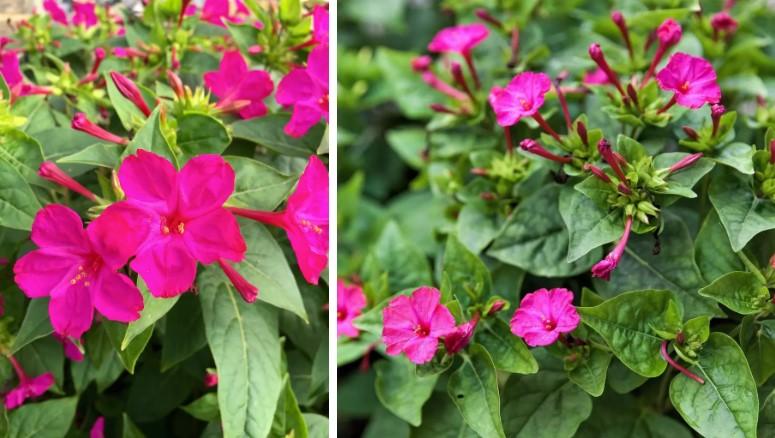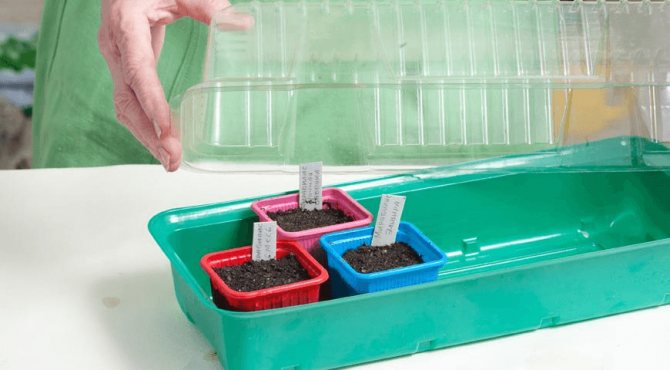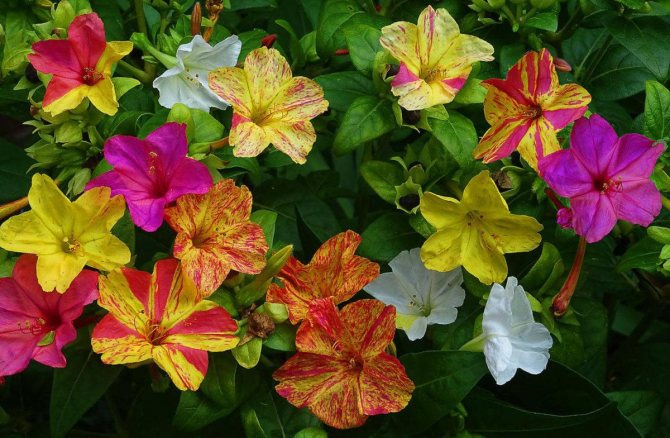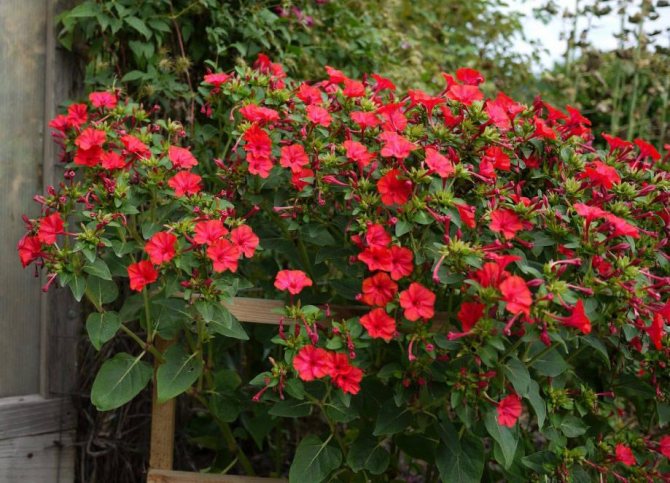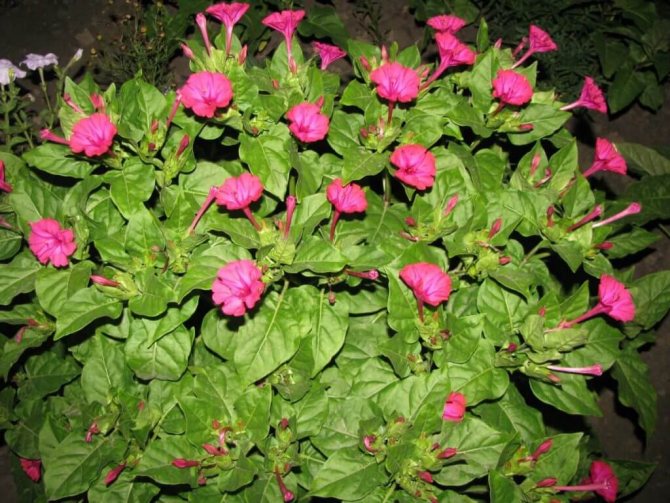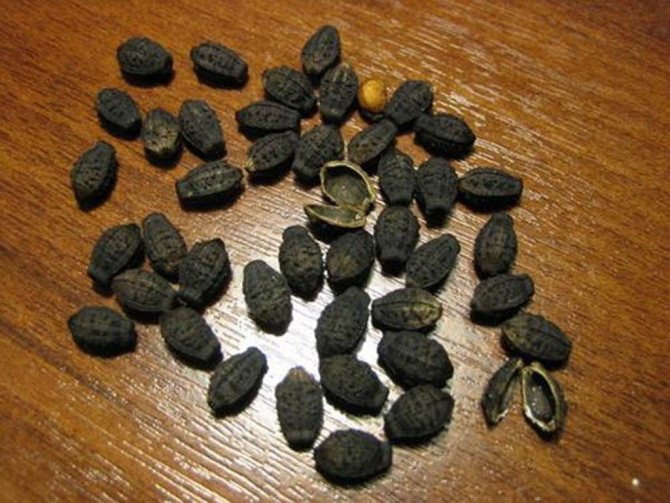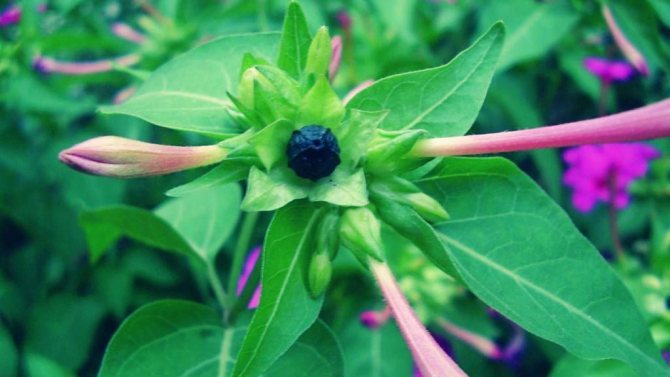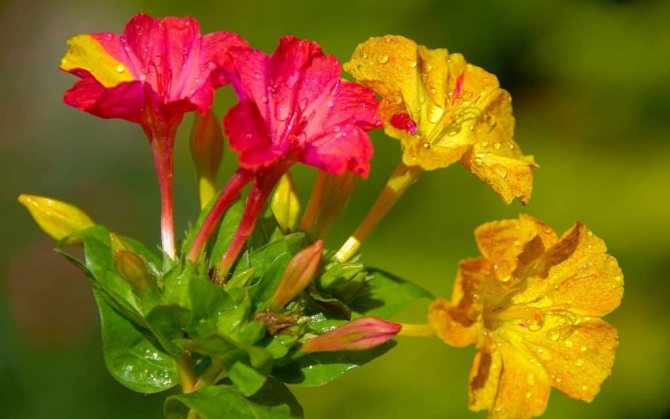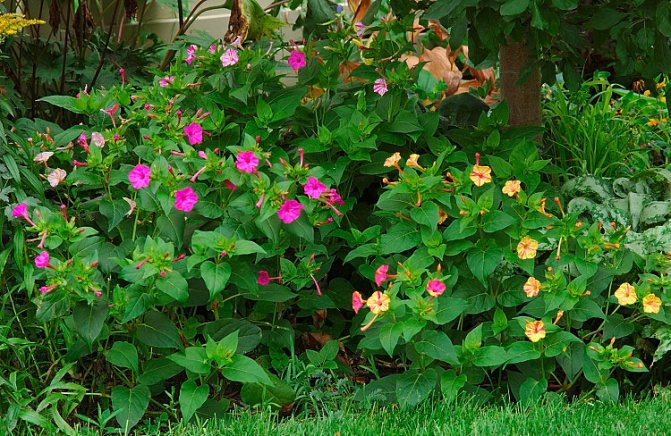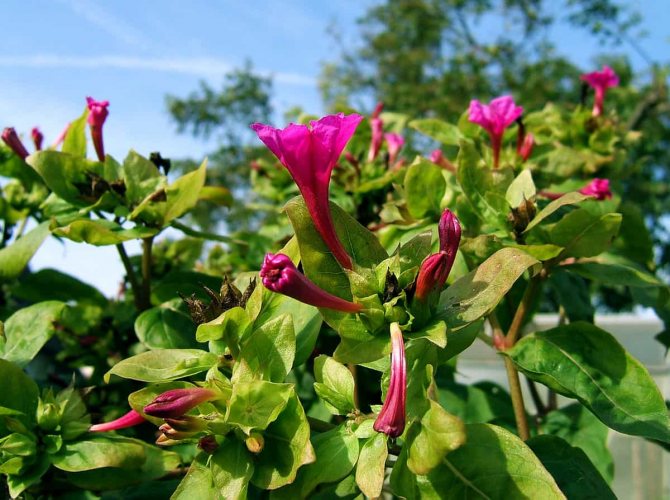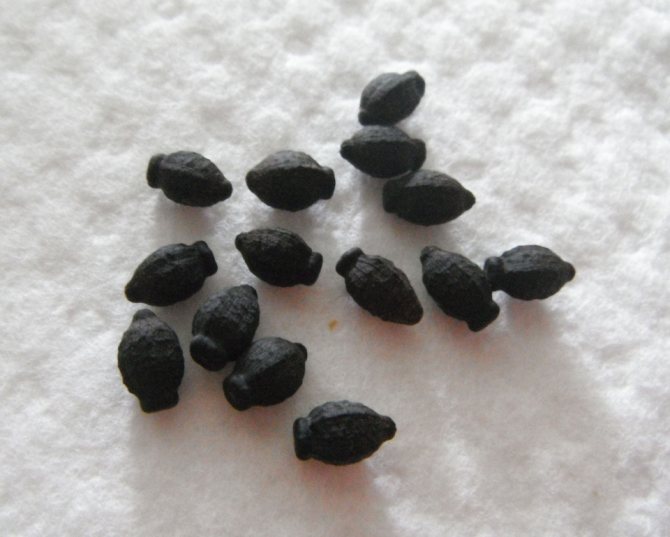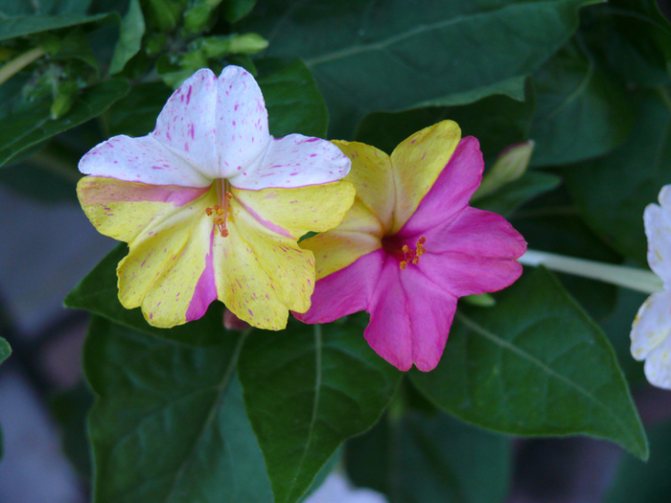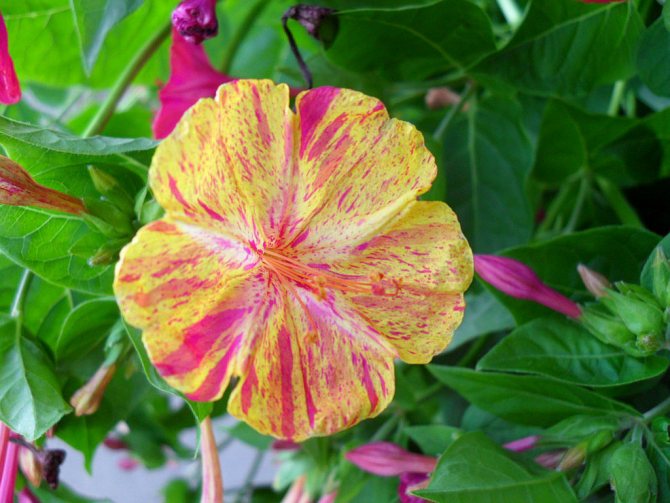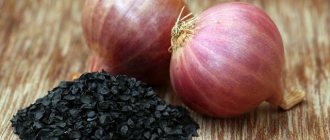Night beauty - a flower from the Niktaginov family (the botanical name of the plant is Mirabilis, which means "amazing"), grows mainly in southern regions with a warm climate. The birthplace of the night beauty is South America. The culture has more than 50 species.
A characteristic feature of Mirabilis is flowering period, the beginning of which falls in the afternoon and lasts until the first rays of the sun. This feature has a simple explanation: the nocturnal hawk moth is the pollinator of the flower.
Description of the night beauty
Night Beauty is the popular name for a typical representative of the Mirabilis clan, which is part of the Niktaginov family. It is called that - mirabilis. In the literature, you can find two names - mirabilisalapa and mirabilislaxative.
Yalapa (Xalapa) is the appellation of the place of natural origin of the flower, which is located on the South American continent. Most scientists consider Mexico to be the birthplace of this flower.
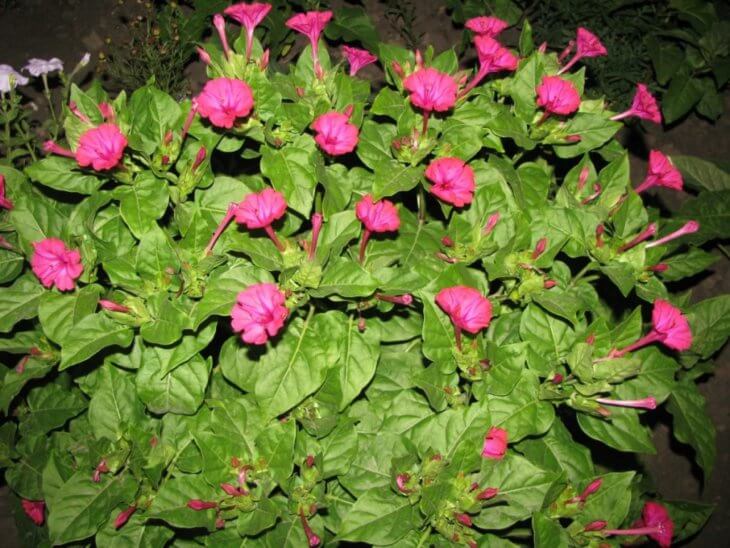
Abundant flowering
Mirabilis means amazing. The first Europeans were so amazed by the beauty of the flower when they came to the continent and saw the plant. Currently, the described beauty is quite popular and is bred in many countries with a tropical climate.
While studying the plant in 1900, scientist Karl Correns made an amazing discovery. When crossing flowers with different colors of petals, the color of either parent is not inherited, since there is a special manifestation of Mendel's law. The genes of the parent do not suppress each other and are of equal strength. The new phenomenon was called incomplete dominance.
It belongs to herbaceous perennials, but in some places it is grown as an annual species. Its bushes can grow to different heights - from 30 to 80 cm.
Mirabilis has highly branched erect stems that are colored reddish. When a plant reaches a certain age, its stems become lignified at the base.
The root system of mirabilis, according to the description, has a tuberous shape.
It blooms at different times depending on the climate. The earlier the warm time comes, the sooner flowering begins.
Usually this is the first half of the summer. Flowers bloom in the afternoon, hence the name of the flowers. Their sweetish aroma is captured by moths from the Brazhnikov family, which, burrowing into stamens, transfer pollen from one plant to another, thereby pollinating them.
Mirabilis flowers, according to the description, can be painted in different tones:
- purple;
- pink;
- yellow;
- red;
- white.
There are also species with variegated colors.
Long funnel-shaped flowers are combined into inflorescences-shields of 3-5 pieces. Each inflorescence is surrounded by a wrapper. One flower contains 5 stamens and one pistil with a short column and an upper ovary.
After the night beauty fades, a fruit forms in place of the flower - a large dark brown achene, bounded by five sharp ribs.
Popular varieties
- Iolanta... It is a spherical bush 50 cm long. It has thick stems with excellent branching at the top. The inflorescences are bright with strokes on the petals. The flowering period is from June to frost.
- Tea time formula mixture... Shoot height up to 90 cm.The leaves are oblong with a sharp end. The stems are well branched, but the lower part is bare. The inflorescences are variegated and 2.5 cm in diameter.
- Tea time red... It is a spherical bush. Stems are knotty and smooth with a light green tint. Their upper part is beautifully branched. Inflorescences are deep pink. The flower takes root well in the northern regions and is resistant to various diseases. The flowering period begins in the second decade of July, until frost.
Iolanta Tea Time Red

Tea time formula mixture

Red lollipop Elvira - Red lollipop... The bush grows wide and can grow up to 90 cm in length. Stems are bare underneath with a good cap at the top. They differ in large inflorescences up to 6 cm in diameter with a bright red tint. The variety is unpretentious and easy to care for. The flower is not susceptible to diseases.
- Elvira... The shrub is dense and rounded. Its average length is 60 cm. The dark green leaves are oblong with a sharp end. Smooth, strong stems with good branching. The inflorescences are brightly colored 3.5 cm in diameter.
How to plant the seeds correctly?
Reproduction of the described plant by seeds is not difficult even for beginners in horticultural business. If mirabilis is already growing on the site, it will spread through the territory by self-seeding, growing rather quickly.
In warm regions, the seeds of a night beauty are planted directly in open ground. Sowing can be carried out in grooves or single pits, keeping the distance between future plants on the order of 30-35 cm.
The landing site should be chosen open enough, mirabilis likes good lighting.
In a temperate climatic zone, the flower is propagated through seedlings. Seeds are sown in separate small containers or a large container at a distance of 10 cm from each other.
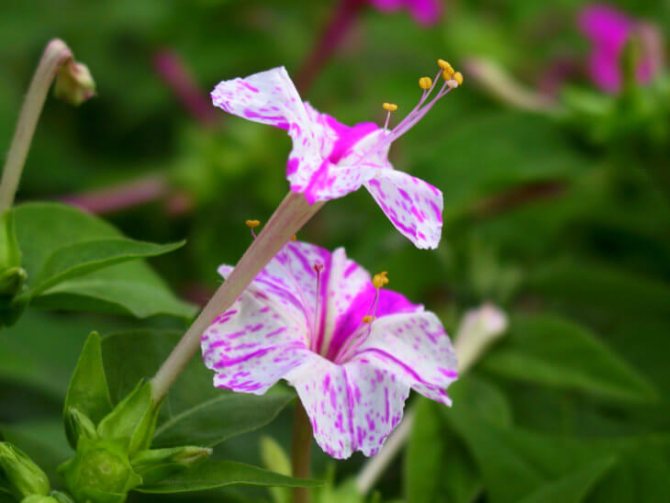

Lat. Mirabilis
The seeds can be soaked in potassium permanganate overnight before planting. Then they are sown to a depth of 2 cm. The soil is well moistened and covered with foil or glass. Periodically, the seedlings are ventilated by raising the glass.
When shoots with a couple of leaves appear, the shelter can be removed. Seedlings are placed on a lighted windowsill and the moisture of the soil is monitored, periodically watering it.
When the shoots are strong enough, you can take them outside for several hours. Thus, hardening is carried out. Seedlings should not be left in drafts.
Planting sprouts to a permanent place in open ground is carried out by the transfer method, having previously well moistened the soil in a container, so that it is easier to extract the plants without damaging the root system.
Having planted seedlings, the soil surface is mulched with peat or wood ash.
Timing for boarding
When sowing seeds in open ground in areas with a warm climate, the optimal planting time is spring, when the threat of night frosts has passed, and the soil and air will warm up to at least + 10 ° C.
When to plant a night beauty for seedlings? Seedlings are sown in March. Plants can be planted in open ground in late spring, depending on weather conditions.
Soil selection
The most suitable soil for a night beauty, according to the description, is limestone and neutral soils, light, with good drainage.
The soil must be fertile enough, otherwise the plant will suffer from a lack of nutrients, and it will be necessary to significantly increase the number of fertilizing.
With increased acidity, lime and dolomite flour are added to the soil.
The soil should absorb water well, but not retain it for a long time. Waterlogging has a detrimental effect on the root system of mirabilis, as well as on other plants.
For sowing seedlings, take ready-made universal soil for flower plants.If possible, the soil substrate can be made independently.
For this, leaf turf, coarse river sand and peat are mixed in equal proportions. For prevention purposes, the resulting mixture is disinfected by spilling boiling water or a solution of potassium permanganate. You can disinfect the substrate by heating it in an oven at a temperature of 180-200 ° C.
At the bottom of containers intended for sowing seedlings, a drainage layer is laid - broken brick, pebbles, expanded clay, crushed foam.
Views
There are six common varieties of mirabilis, which are often grown by flower growers.
Yalapa
It is a popular type and is suitable for decorating large flower beds. The advantages of Yalap include the following:
- multi-colored petals;
- unpretentious care;
- abundant flowering.
Such a flower is planted in early April so that in summer you can enjoy the flowering of mirabilis.
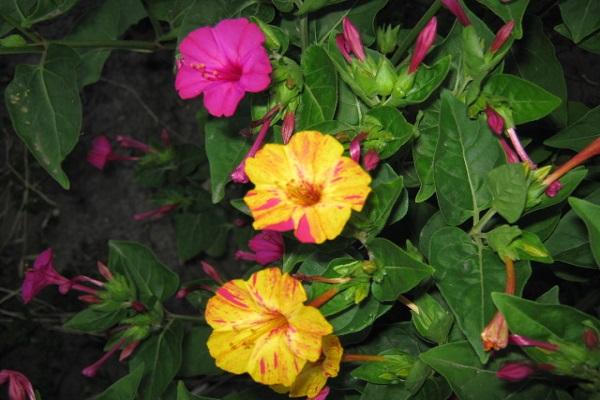

Multi-flowered
A perennial herbaceous seedling that grows up to eighty centimeters. The multi-flowered plant has powerful erect stems, which are covered with ovoid leaves. At the end of spring, inflorescences with a diameter of 4-7 cm form on the bushes of mirabilis.
Reproduction using tubers
Reproduction of a night beauty by tubers is the most common method of vegetative division of a plant. Mirabilis roots can be purchased in specialized agricultural stores ahead of time. They will sit freely in the refrigerator in the fruit and vegetable compartment for several months.
It is easy to get tubers from flowers growing on your own plot. To do this, in the fall, they are dug up, placed in a container with dry sawdust and also placed in the refrigerator. In this state, the tubers will lie well until spring, waiting for the planting time.
One of the varieties of night beauty bloom
Reproduction by tubers allows you to preserve the varietal characteristics inherited from the parent plant.
Tubers are planted in open ground, provided there is no threat of night frosts, or in a ventilated greenhouse.
For the first time, plants planted in open ground can be covered overnight with plastic containers or non-woven material.
In open ground, planting is carried out in April or May, depending on the weather conditions and the climate of the region. Planting pits are dug up to a depth of 10-15 cm and tubers are laid in them sprouts up. If the sprouts are too long, it is better to pinch them up to 10-12 cm.
When planting plants, it should be borne in mind that this flower spreads quickly enough, capturing new territories. Therefore, it is better to plant it away from other flowers, using it as living borders and hedges. Mirabilis also looks good in hanging pots and floor pots and flowerpots.
Features of growing mirabilis
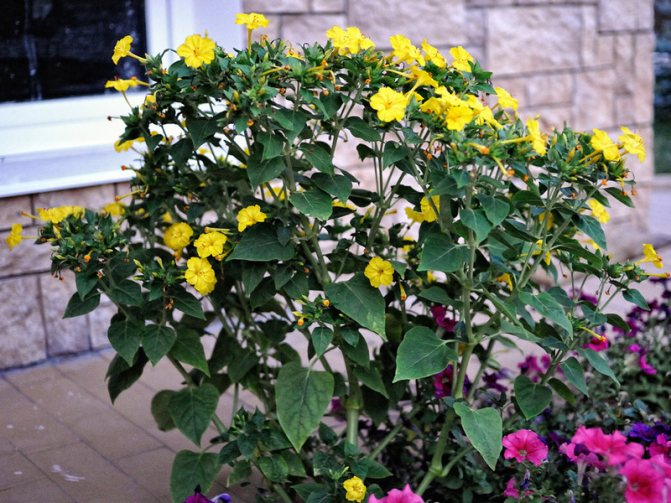

Initially, mirabilis was considered a horticultural culture, which was actively used to decorate flower beds. But thanks to ardent lovers of the plant, it gradually migrated to window sills. For indoor cultivation, it is customary to use undersized varieties. They are planted in spacious pots and placed on the south side. In summer, homemade mirabilises can be taken out onto a balcony or terrace, but they need protection from the wind. Strong gusts can break the delicate stems.
Propagation using cuttings
Reproduction of mirabilis by cuttings is the second method of vegetative cultivation of a plant, which also has a right to exist, so it is quite simple and effective.
With this method of propagation, cuttings are cut from the shoots, half covered with wood. The length of the segments should be no more than 10-12 cm.
The bases of the cuttings are treated with the "Kornevin" preparation or sprinkled with wood ash, having previously dried in the open air for several hours.
Further, the shoots are planted in containers with a pre-prepared substrate or universal soil purchased in a store.
While rooting is taking place, the cuttings are periodically watered and kept in a well-lit place. If necessary, greenhouse conditions can be created for the shoots by covering them with glass or plastic jars.
Rooted cuttings are planted in open ground in a permanent place.
Pests and diseases
Mirabilis exhibits good immunity to diseases and pests. However, if water regularly stagnates in the ground, then root rot of the plant develops.
The affected bush will have to be dug up and burned, and the site should be treated with fungicides, for example, Fundazol. For preventive purposes, it will be necessary to adjust the watering regime.
Sometimes mirabilis can be damaged by rust or mottling. Fight against such fungal diseases can be fungicides. However, all infected leaves and flowers must be removed from the affected plant first.
Night beauty care rules
Mirabilis prefers good lighting, in the shade the plants will stretch and soon lose their decorative properties. With a lack of sunlight, flowering may never start.
The mirabilis flower is very picky about fertilizers.
In accordance with the climate of their homeland, mirabilis prefers warmth, tolerates a slight drought, but is afraid of frost.
You can try to cover for the winter, but in most cases they do not survive the cold season, so in cool climates the plant is often grown as an annual.
Flower care does not require much work and skills. It is necessary to water the flowers from time to time, avoiding waterlogging of the soil. Some time after watering, the land around the plants is loosened.
Fertilizing is carried out several times during the season.
The first time the flowers are fertilized during active spring growth, then during the period of ovary formation and during flowering. Complex mineral preparations for flower plants are used for feeding. It is undesirable to use organic mixtures as fertilizers.
The plantings of the night beauty quickly thicken, and therefore their decorativeness decreases and favorable conditions are created for the development of diseases. Therefore, mirabilis is periodically thinned out. In addition, the bushes lend themselves well to pruning formation.
Amazing flowers
The fact is that these flowers bloom in the evening, when all the others are closed, and delight the eye all night. They close the petals with the first rays of the sun. During the day it is an inconspicuous, even and neat bush. Flowers on it are practically invisible. Its time is evening and night.
This property is associated with its Russian name - night beauty, since it is at night that the bush is covered with bright pink or white flowers, which emit a surprisingly delicate and, at the same time, spicy aroma. Through the efforts of breeders, new colors of the night beauty have appeared. Flowers can be purple, yellow with pink accents, orange, red.
Comments (4)
Masha
21.09.2018 at 00:19 |
I bought the seeds of a night beauty and planted it, nothing worked for me, only 1 bush came up and now it looks very frail, I plan to plant more, but this time ask my sister for seeds.Reply
Nadia
22.09.2018 at 00:43 |
And I also bought seeds of a night beauty, though on the Internet, so not a single bush sprang up at all. You just need to buy seeds from trusted people, then everything will work out.
Reply
Kira
17.10.2018 at 00:15 |
Is this by any chance the flower that flaps and makes sounds as it unfolds? It's just that one of my relatives has a very similar plant in the garden, when its flowers bloom in the evening, they clap.
Reply
Natasha
21.10.2018 at 04:18 |
The night beauty is not particularly whimsical in care, you need to strain only at the initial stage, while the plant gets stronger. If someone hasn't sprouted plants, then you bought defective seeds.
Reply
Application in landscape design


Curb from mirabilis
Mirabilises in landscape design look good if planted in groups. Especially among the green lawn.
- Flowers are used in mixborders and ridges.
- In hedges. Tall varieties are great for this.
- Neighbors can be dimorphoteka, marigolds, nigella, chamomile.
- Low-growing varieties are perfect for decorating terraces and balconies. When planted in deep pots.
- Dwarf varieties are used as edging along the edge of the curb.


